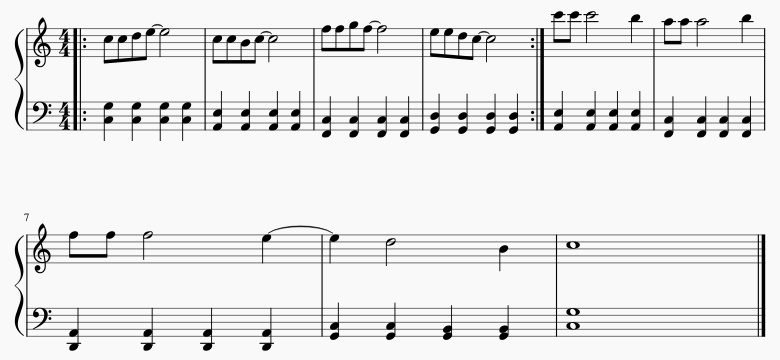
The song "Something Glowing" by Lemon Demon features a rhythmic element that I am currently very infatuated with. It's a technique that, as far as I know, doesn't have a properly recognized name. For the sake of this article, I have decided to call it "Polyphrasing."
For those unaware, polyrhythm is a term referring to the layering of different rhthmic structures, especially different regular divisions of a beat. For instance, a 2:3 (read: 2 against 3) polyrhythm is made up of a set of 2 equally spaced attacks which take the same time to play as a set of 3 equally spaced attacks.
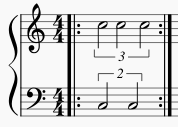
This is one of the simplest and most commonly used polyrhythms. It comes up frequently in music written in meters which are based on divisions of 3 (such as 3/4 or 6/8), in which it can be written without the use of tuplet notation.
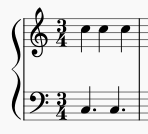
This is an overly simple explanation. This video by Adam Neely is great introduction to polyrhythms and how to visualize and hear them. This article by Josh Merhar explores simple polyrhythms from a drummer's perspective and cites some popular musical examples. For the song I'm going to be analyzing in this post, however, the 2:3 rhythm is all you'll need.
The concept of a polyrhythm can be expanded into larger musical structures. For example, having multiple time signatures going at once is called polymeter. A 2:3 polymeter would overlap and divide the same way that a 2:3 polyrhythm would, just on a larger scale. Similarly, we can have different lengths of phrases playing simultaneously as well.
Where notes are organized into a measure, measures are organized into phrases. Like a time signature, phrases can be any length, and an uneven phrase length such as 3 or 5 bars can feel unbalanced or sudden, especially when combined with other phrase lengths. Because of this, most popular music sticks to groupings of 2 or 4 measures. This organization feels very natural, and you may have noticed that while listening to music, you can usually guess when the next part of a song is coming, even if you haven't heard the song before. Listen to the example below:
This short example I wrote isn't perfect, as the simple chord progression clues the ear into moments of tension and resolution, like with the G chord resolving back to C the first time, then to A minor, C major's relative minor. Still, the repetitive four bar structure establishes a pattern that our brains are quick to pick up on. Even though we don't know what's going to happen, the organization of measures tell our brain when enough time has passed for a new musical idea to enter the song.
Here's the sheet music:

Of course, the brain can still get used to a more unusual phrase length so long as it is regular. It's finally time to start talking about the topic of this post! Here's the progression from Something Glowing that repeats for most of the song:

As you can see, this chord progression is comprised of 3 bars. This repeats dutifully throughout most sections of the song. Even when this 3 bar progression is first introduced, there is a short melody line which repeats every 2 bars, not fully resolving with the chord progression until it has played twice, for a total of 6 bars. Keeping this in mind, our expectations are set for the rest of the song.
At first, the vocals support the 3 bar structure perfectly, with the first half of the verse splitting up nicely into 4 sections of 3 bars each:
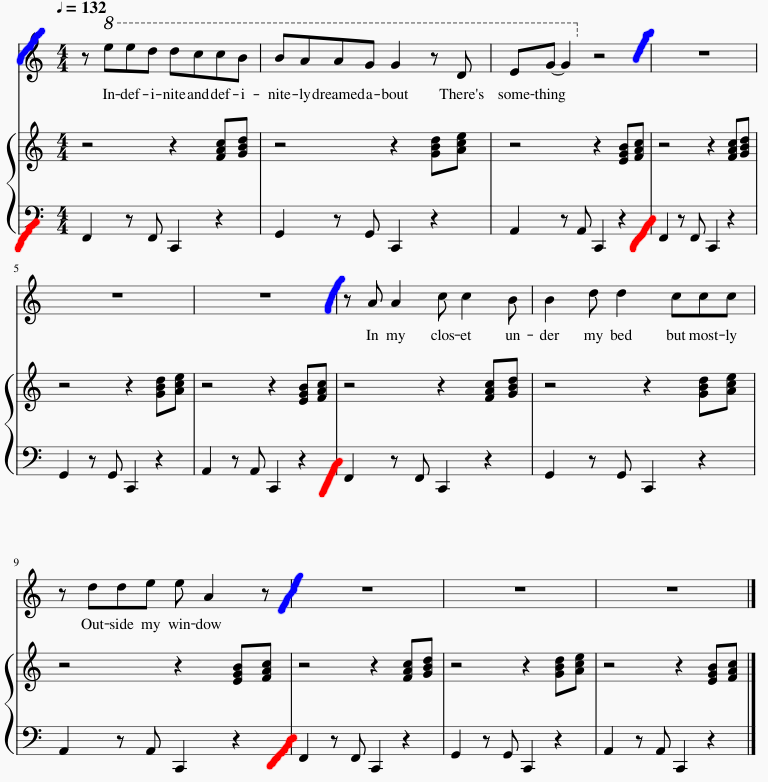
I've marked the start of each phrase for both the chord progression and the vocals here, with the former in red and the latter in blue. As you can see, both parts are lining up very nicely for a regular, though unusual, 3 bar phrase length. However!
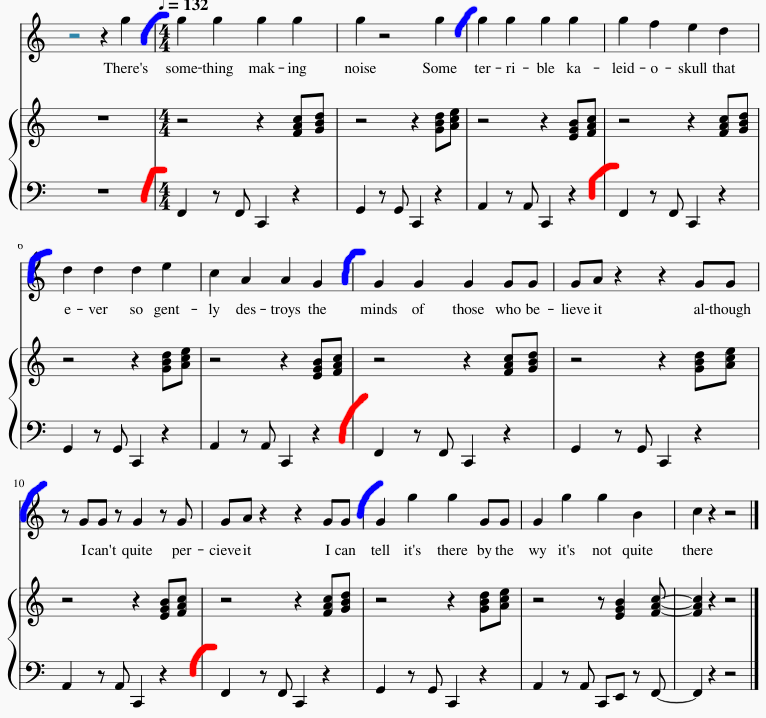
When the second half starts, things are immediately made more ambiguous. I've marked the vocals here as forming into groups of two, forming a 2:3 polyphrase with the chord progression. I'll admit that there's not a ton of evidence for this grouping, but it feels right to me - especially when paired with that repeating melody line from earlier. To me, at least, the vocals definitely don't line up with the 3 bar grouping.
It could be argued that both parts are combining to simply form a 6 bar phrase. This makes sense, as 6 bars is the smallest grouping in which both parts always synch up, but I feel like that's kind of a narrow-minded view of what's happening musically in this song. The feeling of instability that the polyphrasing provides in this song is very real, and it lends itself to the song more than just harmonically. Something Glowing is a song about a person struggling to observe an incomprehensible object, driving themselves mad in the process. Neil Cicierega wrote that the song was "inspired by the creepier side of the childhood perspective" in View-Monster's HTML file.
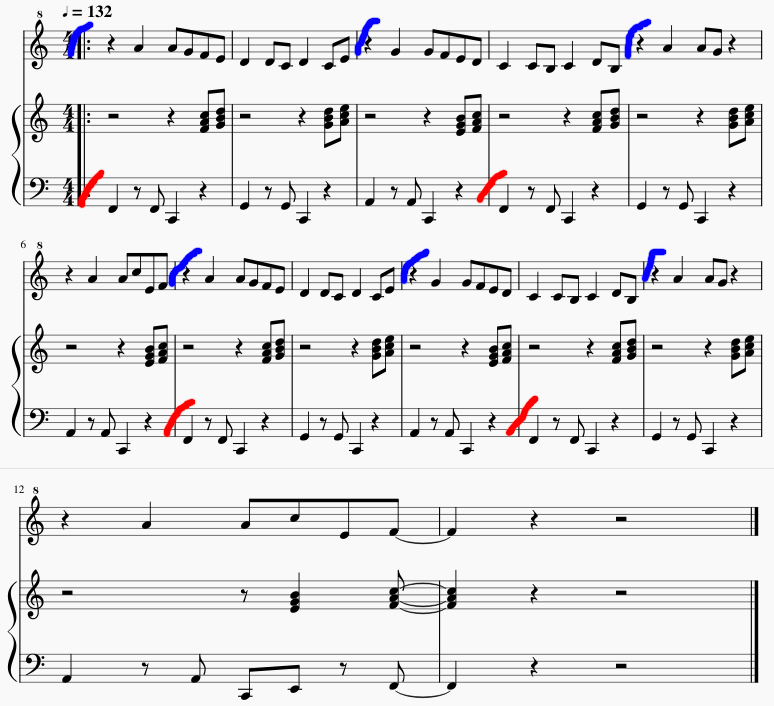
In the chorus, we can see this polyphrase more clearly. Each phrase of the vocal line starts with the same "2, 3-and" rhythm, and the second phrase is a direct modification of the first. This is exaggerated later in the bridge, where the first two phrases of this chorus melody are repeated without the third phrase a total of 3 times, before a more modified version kicks in. This results in the section taking a whopping 12 bars for the 2 parts to synch up again, as the total 4 bars of the first two phrases in the melody divide even less cleanly into the 3 bar phrase of the chord progression. (If we think of the 4 repeating bars of the melody line as one, longer phrase, this technically forms a 4:3 polyphrase! Awesome!) This, of course, further adds to the feeling of instablity.
I think that the feeling created by this polyphrasing lends itself perfectly to the song. Any smaller form of polyrhythm would, of course, still create a sense of unease, but it would also stick out much more, especially with polymeter or a dense polyrhythm. A 2:3 polyphrase is perfect for adding that gentle touch of oddness while not disrupting the warm, tingly flow of the song. Like the lyric: "I can tell it's there by the way it's not quite there". Just the right amount of mismatching, the kind you likely won't notice at first, or that you will need to transcribe and annotate to convince yourself that it's actually happening.
Not that I know anything about that.